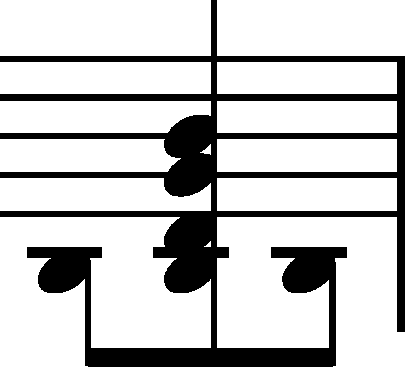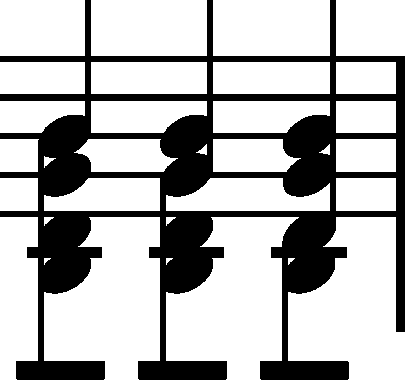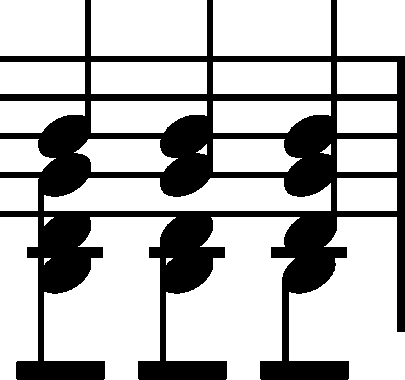




|
Tie & slur in JC |
|

|
Ties in EF |
|

|
Suggested supplement to EF ties |
|

|
Ties in PE, possible interpretation |
|

|
Slurs in PE, probable interpretation |
The notation and performance of the 2nd and 3rd beats of bars 52-53 and analogous pose a complex editorial and performance problem comprising:
- need for considering a number of various elements of notation together, such as: slur-like lines (ties or slurs), not always entirely clear as to their meaning, arpeggios, division into voices, as well as the indication tenuto;
- differences between various sources, differences between analogous bars, differences between the parts of both hands, ambiguities and more or less probable errors of notation, as well as possible revisions of EF.
The starting point for further analysis is a belief that the performance of bars 52-53 and 60-61 (as well as of bars 88-89 and 96-97, which were not written out in autographs) should be equal in terms of their basic writable elements. In turn, there is no reason to unify the notation of the parts of both hands or to adapt the notation of bars 52 (60, 88, 96) and 53 (61, 89, 97). It leads to the following arrangements:
- The slur-like lines in the sources which do not display signs of revisions (JC and PE) appear only – in the parts of both hands – in bar 52 and analog., whereas their appearance does not clearly indicate whether they are ties sustaining the d and d1 notes or slurs. Considering the slur-like lines as slurs allows to accept the version of PE without changes, as the lack of slurs in bar 60 does not have any impact on the performance in this context. We adopt this version, which is also compatible with JC, as the main text. Considering the slur-like lines as ties leads to an alternative interpretation of PE, which is, according to us, less plausible, although it also agrees with JC and, what is more, it is generally compatible with the notation of EF. The latter one can also be interpreted, adding the ties in a way which is given by us as one of the possibilities. However, it does not exhaust possible attempts to interpret the slur-line likes in those bar, yet we do not include them, considering them to be even less plausible.
- Arpeggios in bar 52 and analog. appear only in the part of the L.H. and only in the previous sources. In the main text, following the base source (PE), we do not include them. However, the presence of arpeggios in the parts of both hands in bar 53 and analog. does not raise almost any doubts.
-
The problem of division of the chords on the 3rd beat of the described bars into two marked voices (lower in quavers and upper in crotchets) certainly stems from the notation of the autographs. Chopin generally put stems on the right-hand side of the notes. A four-note chord written by Chopin, e.g., in the 2nd half of bar 53, would probably look like that:
 . Theoretically, it could mean each of the following notations:
. Theoretically, it could mean each of the following notations:  . We also have to take into account the fact that not always did the composer pay attention to the gap indicating a total separation of the voices, hence we also have to consider the following possibilities:
. We also have to take into account the fact that not always did the composer pay attention to the gap indicating a total separation of the voices, hence we also have to consider the following possibilities:  . As far as the layout is concerned, the problem is sometimes irresolvable even when we have a preserved autograph, not to mention the situation in which all what is left are derivative sources. Therefore, all we can do is to analyse the musical factors which do not directly derive from the notation, as, e.g., the logic of voice-leading or a convenient piano grip. In case of the described places, at the time of choosing the notation adopted in the main text, the editors took into account similar figures in bars 68-69, where due to a different graphic layout of the base source (PE), the division into voices is unquestionable.
. As far as the layout is concerned, the problem is sometimes irresolvable even when we have a preserved autograph, not to mention the situation in which all what is left are derivative sources. Therefore, all we can do is to analyse the musical factors which do not directly derive from the notation, as, e.g., the logic of voice-leading or a convenient piano grip. In case of the described places, at the time of choosing the notation adopted in the main text, the editors took into account similar figures in bars 68-69, where due to a different graphic layout of the base source (PE), the division into voices is unquestionable.
From the practical point of view, the editors believe the version of the main text to be the most recommendable one, as far as the source, sound, and practical issues are concerned. In bars 52 and 60, it is justified to sustain the d and d1 notes and to consider the arpeggio in the L.H. (also together).
Compare the passage in the sources »
category imprint: Graphic ambiguousness; Interpretations within context; Differences between sources
issues: Inaccuracies in PE, Errors in Fontana's editions, Inaccuracies in JC, Fontana's revisions
notation: Rhythm
